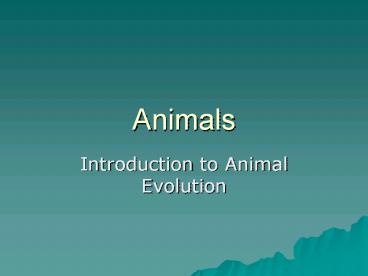Animals - PowerPoint PPT Presentation
Title:
Animals
Description:
Animals Introduction to Animal Evolution What is an Animal? Multicellular, heterotrophic, eukaryotes Cells lack cell walls, held together by structural proteins ... – PowerPoint PPT presentation
Number of Views:102
Avg rating:3.0/5.0
Title: Animals
1
Animals
- Introduction to Animal Evolution
2
What is an Animal?
- Multicellular, heterotrophic, eukaryotes
- Cells lack cell walls, held together by
structural proteins (collagen) - Contain nervous and muscle tissue
- Most reproduce sexually with a dominant diploid
stage
3
Development
- Zygote (cleavage)
- Morula
- Blastula
- Gastrula
- Blastopore
- Archenteron
- Two layers of tissue (endoderm ectoderm)
4
Origin of Animals
5
Animal Phylogeny
6
Animal Phylogeny
7
Animal Phylogeny Overview
- Organization Level
- Body Symmetry
- Body Cavities
- Development
- Segmentation
8
- Organization Level
- Cellular Level vs. Tissue Level
- Cellular Level Porifera (sponges)
- Tissue Level all others
9
- Body Symmetry
- Radial vs. Bilateral
- Radial Symmetry Cnidaria Ctenophora
- Bilateral Symmetry all others
10
- Body Cavities
- Acoelomates Platyhelminthes (flatworms)
- Pseudocoelomates Nematoda (roundworms)
- Eucoelomates all others
11
- Development
- Protostomes vs. Deuterostomes
12
Protostomes vs. Deuterostomes
- Cleavage
- Radial and Indeterminate
- Coelom Formation
- Enterocoelous
- Formed from pockets of the archenteron
- Fate of Blastopore
- Anus
- Cleavage
- Spiral and Determinate
- Coelom Formation
- Schizocoelous
- Formed from 4D cells
- Fate of Blastopore
- Mouth
13
- Development
- Protostomes vs. Deuterostomes
- Protostomes
- Mollusca (clams, snails)
- Annelida (segmented worms)
- Arthropoda (Crustaceans, insects)
- Deuterostomes
- Echinodermata (Seastars)
- Chordata (vertebrates)
14
Segmentation
- Mollusca (soft - unsegmented)
- Annelida (soft segmented)
- Arthropoda (hard segmented)
- Chordata (segmented)
15
Which Phylogeny?
16
Points of agreement
- 1. All animals have common ancestor
- 2. Sponges are basal animals
- 3. All other animals have true tissues
- 4. Most animals are bilateral
- 5. Chordates and Echinoderms are related
(deuterostomes)
17
Points under Contention
- Animals not in the clade deuterostomes are
divided into two groups - Ecdysozoans
- Lophotrochozoans































